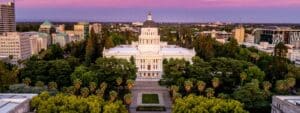Sue McAllister
The Bay Area can meet its need for new homes and workplaces over the next quarter-century without encroaching on its open spaces or sending residents on mega-commutes into outlying valleys, says a report released Wednesday by an environmental group.
By focusing new housing construction on underused sites in seven “smart spots” ringing the bay, more than 80 percent of the region’s projected need for housing can be met by 2035, according to a three-year study by Greenbelt Alliance.
The report, titled Grow Smart Bay Area, is not just an attempt to figure out where in the Bay Area to squeeze in the additional 2 million people and 1.7 million jobs that are predicted to fill the nine-county region in the next 26 years, according to Greenbelt Alliance executive director Jeremy Madsen.
“It’s about using that growth as a tool to create even better neighborhoods, surrounded by the stunning beauty of the open spaces the Bay Area has to offer,” he said during a panel discussion about the report Wednesday in San Francisco. “We need to focus where we already have jobs, shops and other services,” not build on open space or in far-flung suburbs.
One of the seven areas where underused land — such as old strip malls, seldom-used parking lots and low-rise office parks — could be redeveloped into housing, shops and pedestrian-friendly neighborhoods is northeast Santa Clara County, the group said.
Greenbelt Alliance estimates that the area could provide 26 percent of the Bay Area’s housing needs over the next couple of decades, in the form of “infill development,” which is urban planners’ term for building within a city or suburban core, not on vacant land at the city’s edges. The group cited parts of North First Street, parts of The Alameda, and areas close to downtown San Jose as prime spots for redevelopment.
Greenbelt and many other groups say infill development can foster neighborhoods in which people drive less and walk, bike or take public transit more, reducing traffic and pollution.
But there are many hurdles confronting planners and developers who want to create more infill housing, said Cheryl O’Connor, acting CEO of the Home Builders Association of Northern California. O’Connor said her organization agrees with Greenbelt that more infill development is a worthy goal. But infill alone won’t provide enough housing for a growing Bay Area, she said.
“In practicality, it doesn’t really solve the problem because there are so many challenges to creating urban infill,” she said. Those include neighbors’ frequent resistance to plans for “high-density” housing like apartments and townhouses; lengthy government approval processes for housing developments; and zoning regulations that must be changed before housing would be permissible on many parcels.
In San Jose’s North First Street area, for example, the city of San Jose’s vision for 32,000 new housing units has not been popular with officials from the Santa Clara Unified School District, which would serve many potential residents but would need to build new schools to do so.
Besides, O’Connor said, not everyone seeking to live in the Bay Area in 2035 will want to live in apartments or condos close to rail lines and within walking distance of grocery stores, attractive as that sounds to many people. “You still do have people who want to make other choices,” she said.
San Jose Mayor Chuck Reed, who was part of the panel discussion about the report Wednesday in San Francisco, said San Jose must strive to grow in ways that will attract creative residents who will keep Silicon Valley at the forefront of technological innovation. That goal, he said, means keeping the city an enjoyable, beautiful place to live.
“We simply have to find a way to accommodate the economic development, and the people that go with the economic development, without destroying our physical environment,” he said.
* * *
BAY AREA GROWTH “SMART SPOTS”
The Greenbelt Alliance is encouraging future growth in seven “smart spots” “” especially those along transportation corridors. The group used an inventory compiled at UC-Berkeley of sites likely to be redeveloped because the structures on them are worth less than the land underneath. They then made predictions about the potential future use of 40,000 of those sites.
Northeast Santa Clara County: Can accommodate 26 percent of the region’s need for housing units and 20 percent of its need for job growth. Key areas for infill development: Parts of North First Street and The Alameda, and areas close to downtown San Jose.
Peninsula: Can accommodate 14 percent of growth in both housing and jobs. Key area: Along the El Camino Real corridor.
San Francisco: 8 percent of growth in housing, 16 percent in jobs. Key areas: Around public transit
Other areas: Southern Alameda County, Contra Costa County, the Sonoma-Marin Area Rail Transit corridor and the inner East Bay
###




